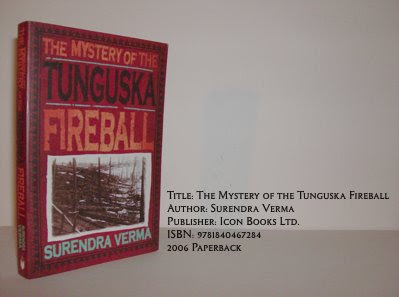Around 7:14 A.M. on June 30 1908 the Siberian heartland was shook by a colossal explosion, with a strength equivalent to 1000 Hiroshima atomic bombs. The effects of this cataclysm were felt worldwide: shockwaves were registered around the planet, for weeks Europe had unusually bright nights and disturbances were measured on Earth's magnetic field. More than 100 years have gone by and the definitive answer for such dramatic event still eludes the scientific community.
The debate has flourished between scientists and passionate investigators and the theories that purportedly explain the mystery are diverse, ranging from the plausible to the absurd. Strangely, the available literature in english about the Tunguska Event is scarce, making this work by Melbourne based science writer Surendra Verma a gem of sorts.
The structure of “The Mystery of the Tunguska Fireball” is very straightforward: it starts with an overview of the happening and its immediate consequences and then follows a path of historical review of the various expeditions and scientific studies performed on the spot. The lifelong work of Leonid Kulik, scientist and leader of the first expedition to observe the devastating effects of the catastrophic occurrence (1921), is carefully scrutinized. His theory was that the Tunguska Event was caused by the impact of a meteorite and this is a possibility that still has many followers. The evidence on the ground though was quite frustrating and Kulik died without ever discovering the massive impact crater he expected to find.
The procession of theories begins to unfold from the third chapter onwards. The comet hypothesis, first suggested by the astronomer F. J. W. Whipple in 1934, became one of the most solid and supported through the decades. But as the expeditions to Tunguska became more frequent and well equipped, more puzzling data began to emerge. Small spheroid particles were found scattered around the epicentre of the explosion and bizarre increases in annual tree growth served as support for stranger possibilities. The impact of a black hole, antimatter and even the spectacular crash landing of an ailing extraterrestrial spacecraft, were some of the theories that met more or less criticism from the scientific community and the media.
Surendra Verma must be lauded for the impartial treatment of every hypothesis, allowing the reader to make his own judgement. As an author he took the right approach, strongly cementing his book on published scientific studies and through direct contact with some of the investigators who spent (and still spend) long summers on the inhospitable Siberian wilderness in search for the answer to one of the truly great mysteries of the 20th century.
More information on the Tunguska Event may be found on Wikipedia (http://en.wikipedia.org/wiki/Tunguska_event), which also contains further links for websites pondering on this enigma.



Nice post. Did they ever find out what caused the great tunguska incident?
ReplyDeleteI think it must have been some government experiment because it is strange that such an event would take place in such a remote area. Usually you pick remote and places with little population to test new findings even if no government has stepped forward to admit it. I've also read another good book on this subject, or maybe a chapter from some other book, I can't tell for sure :\
Keep'em coming man!
Thanks for your comment.
ReplyDeleteRegarding to your suggestion I have to add that this same book by Surendra Verma mentions a theory according to which the Tunguska Event was caused by an experiment by the mythical inventor Nikola Tesla. It was suggested that he was testing his "Death Ray" and, after realising the catastrophic results, Tesla destroyed his weapon. Of course this is an unsubstatiated proposition, but allows an interesting peek into the sociological repercussions of a yet unexplained mystery. Where science fails the "speculators" come into action and cover the enigma with a veil of smoke.